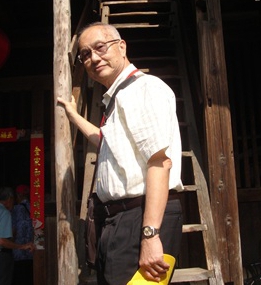第一部以华文书写的《新加坡华人通史》即将出版
“A General History of the Chinese in Singapore” soon to be published
文:欧雅丽
新加坡宗乡会馆联合总会为庆祝新加坡共和国成立50周年暨宗乡总会成立30周年而出版的历史专著——《新加坡华人通史》将在今年11月9日宗乡总会30周年庆典晚宴上隆重推出。宗乡总会副会长钟声坚在2015年7月8日召开的《新加坡华人通史》媒体发布会上对外公布这一消息。
宗乡总会自2013年3月首次提出《新加坡华人通史》的出版计划,前后共耗时三年多完成了此书的筹备工作。据《新加坡华人通史》的主编柯木林透露,这本书的样稿目前已出炉,计划于今年9月付梓印刷。这本书涵盖了14世纪迄今新加坡近700年的历史,时间跨度大,内容丰富,页数厚达800页,字数约80多万字,总共斥资18万元,动员了新、马、中、港、澳(洲)37位学者和文史工作者共同编撰完成,是本地第一部以华文书写的新加坡华人通史。
何谓通史
柯木林主编说,通史是史学著述的一种体例,通过这种体例,连贯地记叙各个时代的历史,涉及重大的历史事件,杰出的历史人物及多种领域的文化等。在叙述中要体现出历史发展的轨迹或贯穿其中的线索,让读者对历史有整体的认识。
《新加坡华人通史》是介于学术与通俗之间的历史专著,内容涵盖广,从开埠前的“古代新加坡”到建国后的经济转型;从华人上层社会的领袖人物到普通民众的生活面貌;从落叶归根的华侨到落地生根的新加坡华人;从文化认同、政治觉醒到本土意识的萌芽、茁壮和成长,以及宗教、文学、美术、影视及表演艺术等方面均有涉及。这本书的各章节以新华社会的各个方面为主题作专题论述,通过对各个主题的梳理,来勾画出新加坡华人社会的全貌。
为了能全方位,多角度的诠释历史,《新加坡华人通史》的编委会成员包括了历史学者、大学教授、文学研究者、人类学者、古建筑学家、翻译工作者和报人等。参与撰写的作者也包括了本地学者、国外学者和新移民,既有学术成就斐然的年长学者,也有崭露头角的年青学者,可谓是老中青三结合。这样的安排,不仅保证了各篇章的质量,有学养深厚的专家名篇,也体现了史学研究的传承,给年轻学者一个好的平台。
为了增加《新加坡华人通史》一书的可读性,本书采用了图文并茂的形式,编委会精心选择了300多幅插图,除基本图片外,很多图片都是未经发表过的。全书采用彩色印刷,丰富的图片资料增强了此书的可读性,从视觉上让读者了解新加坡华人社会的历史。此外,在书本的编排上,《新加坡华人通史》的每篇文章在开篇均有中英文摘要,让读者能迅速了解本节内容;在书本的右页边栏还安排了从1348年到2015年的新加坡历史大事记,供读者浏览并快速了解新加坡重大的历史事件。
鲜为人知的历史
据柯木林主编介绍,《新加坡华人通史》发掘了一些鲜为人知的历史,比如今年恰逢新中建交二十五年,其实新中建交的历史远远不止二十五年。早在1877年,清政府就在新加坡设领事馆,至1911年共派驻12位驻新加坡领事;中华民国在1912至1950年间,也派了17位总领事驻新加坡;中华人民共和国自1990年与新加坡建交后,也派了10名特命全权大使。新中交往的历史源远流长,清政府最早在海外设置领事馆的地方就是新加坡。本书中有一个章节专门介绍中国驻新加坡领事的历史。
2015年7月4日,新加坡植物园申遗成功的消息举国兴奋。“其实,世界遗产早就在我们的家里了,早期的家书就是世界遗产。”柯木林说,2013年6月19日,在韩国光州召开的联合国教科文组织世界记忆工程国际咨询委员会第十一次会议上,“侨批档案”成功入选《世界记忆名录》,成为世界文献遗产的项目。新加坡曾是侨批的区域中转枢纽,周边国家要寄侨批回中国,都集中在这里再转寄出去。战后,在新加坡经营侨批业务的民信业曾盛极一时。《新加坡华人通史》专辟一章,阐述侨批的历史。
还有一些鲜少人研究的历史,如新华“士”阶层、新华古典文坛、新加坡左翼文学的文革潮等,《新加坡华人通史》均有涉猎。本书最后一章《两百年来谁著史》,梳理了新加坡自开埠以来,有关新加坡华人的参考文献,可以给有志于研究新华历史的学者提供参考。
除此之外,《新加坡华人通史》也力求做到保存史料、勘正史实。例如在本书的附录部分,有“新华先贤五十名”的介绍,在人物介绍时,尽量做到精细,人物的祖籍地追溯到具体的村社,如薛佛记祖籍福建省漳州市漳浦县石榴镇东山村上营社。对一些经过最新研究成果证明有误的史料,本书也进行了更正。如胡文虎永安堂是1926年在新加坡创立,而非传统说法是1923年;新加坡美术界的开山鼻祖是创办于1922年的“新加坡华侨美术学院”,较南洋美专的创办还早16年。
曾经的文化重镇
一直以来,政府都致力于将新加坡发展成为具有特色的国际艺术之都。其实,回顾历史就能发现新加坡曾经也是一个文化重镇,蕉风椰雨文学、美术、影视、戏剧等都有其光辉灿烂的时刻。
柯木林介绍,在19世纪末新加坡就有一个新华“士”阶层,即知识分子阶层,这个阶层的人士结社吟诗,文艺活动十分热闹;同样在十九世纪末,新加坡就出现了儒学运动。当时的倡导者邱菽园和林文庆在1897年至1907年间,积极宣扬儒学,影响及于近邻各埠,使崇儒尊孔之风遍及南洋。其思想和活动与20世纪80年代的新加坡儒学运动有着很多相似之处。从这些历史中,也可以给今天新加坡艺术的发展一些启示。
《新加坡华人通史》也得到了本地许多文化人士的热心支持。蜚声国际的历史学家王赓武教授为本书作序,书法家曾广纬为封面题字,而本书封面则采用了画家林子平的一幅画作。
考虑今后推出英文版和海外版
钟声坚表示,自去年6月宗乡总会对外宣布出版《新加坡华人通史》后,有多家海外出版社来函与宗乡总会洽谈海外版权事宜,宗乡总会正在和这些出版社商谈,希望能找到适合的出版社发行海外版。此外,为了让更多新加坡人了解新加坡华人历史,宗乡总会也计划将来出英文版。
宗乡总会的秘书长兼《新加坡华人通史》编辑顾问李国基在发布会结束时说:“这本书对新加坡华社过去的历史作了系统性的梳理,为我们的子孙后代留作参考。我认为这项工作既是总会应该完成的一项历史使命,也是我们这一代华社人应完成的历史使命,希望这本书能得到全体华社的支持。
《新加坡华人通史》首印2300本,定价每本80元。现在订购可以享受优惠预购价,每本仅售49.9元,订购电话63544078。
The Singapore Federation of Chinese Clans and Associations (SFCCA), in celebration of 50 years of the Republic of Singapore, has produced a publication entitled “A General History of the Chinese in Singapore” 《新加坡华人通史》 to be officially launched on 9th November at the SFCCA’s 30th Anniversary Dinner. This news was announced by Vice-President Mr. Zhong Sheng Jian on 8th July 2015 at the book’s pre-launch media publicity event.
According to Chief Editor Mr Kua Bak Lim, the book begins with Singapore in the 14th Century till the present, covering a period of almost 700 years. It had drawn upon 37 scholars and editorial contributors from Singapore, Malaysia, China, Hong Kong, and Australia.
Why called “General History”?
Mr Kua explained that general history is a category of history-writing that is topic-based. Topic-based authoring will create a narrative of different periods of history, which is most suitable for presenting significant historical events, outstanding personalities and diverse cultures.
“A General History of the Chinese in Singapore” encompasses both academic and layman’s interest. From pre-founding “ancient” Singapore to economic transformation via nation building; from the leadership of eminent Chinese to the lives of the ordinary people; from the landing of Chinese immigrants here to the sinking of roots as Chinese Singaporeans; from cultural interaction, political awakening to germination and maturity in religion, literature and arts, audio-visual and performing arts are all taken into consideration. The complete picture of Singapore Chinese society is fleshed out through the studies from the various specialists who have contributed to the book.
The editorial board has carefully selected 300 over illustrations. All illustrations are in full colour, complete with copious write-ups making it highly readable and allowing readers to comprehend Singapore Chinese history at a glance. A summary in English and Chinese is provided at the beginning of every essay in the book. The timeline at the right margin of the book allows readers to quickly trace all major historical events which happened in Singapore.
Fresh Historical Insights
Mr Kua revealed that the book has some fresh historical insights. For example, this year is coincided with 25 years of establishment of diplomatic ties between China and Singapore. However, the relationship stretches ways back in 1877. The Qing government already had a consulate office in Singapore at that time. Qing government had sent altogether 12 ambassadors to Singapore since then. The Republic of China government sent 17 consuls from 1912 till 1950; and the People’s Republic of China has sent 10 plenipotentiary ambassadors since 1990.
It was indeed rejoicing news of Singapore Botanic Gardens’ successful recognition as a world heritage. “Actually, a world heritage has long been in our homes. The early family letters is a world heritage.” said Mr Kua.
On 19th June 2013 during a UNESCO committee meeting in Gwangju, South Korea, the “Qiaopi archives” (“侨批档案”) has been successfully inscribed into the “Memory of the World Register”. Singapore used to be a regional money remittance hub. The business of “Qiaopi” remittances became extremely successful immediately after the war. A specific chapter on history of “Qiaopi” is written for the book.
There are also some rare fresh insight researches, like the Singapore Chinese “scholar” class, Singapore Chinese classical literature as well as left-wing writings during the Cultural Revolution. The last chapter of the Book is a “200 Years Historical Who’s Who” listing from the time of Singapore’s founding, providing a reference source for researchers.
Besides all these, “A General History of the Chinese in Singapore” also stresses the preservation of legacies and verification of historical facts. For example, in the Addendum of the book is an introduction of “50 Singapore Chinese forebears”, in which the biographical essays delve into the finest details even up to their respective village homesteads. It was also verified that Mr Aw Boon Haw’s company Eng Aun Tong was established in Singapore in 1926 and not the traditionally accepted 1923.
Once a Cultural Revival Centre
All along, the Government has strived to develop Singapore as an outstanding international arts centre. Actually, Singapore was once a centre of arts revival. Tropical literature, fine art, film making and drama, all had their periods of shining brilliance.
Mr Kua stated that towards the end of the 19th Century, Singapore had a scholar class who were the intellectuals of their days. Singapore also saw a Confucianism movement in which Khoo Seok Wan (邱菽园 ) and Lim Boon Keng ( 林文庆 ) were the founding leaders. That movement had some similarities with Singapore’s Confucian study in the 1980s and may inspire our future.
Planning an English edition and an overseas edition
Mr Zhong Sheng Jian said that, since the announcement of the publication of “A General History of the Chinese in Singapore” last June, several publishers had contacted SFCCA asking for the right for publishing and distributing overseas. It has now entered into a selection process. Furthermore, SFCCA is planning an English edition in order to reach out to a wider readership in Singapore.
SFCCA Secretary-General and Advisor to the Editorial Board of the book, Mr Lee Kwok Kie believed that this is a legacy laid by SFCCA for our future generations. He hoped that the book would receive strong support from the Chinese community.
2300 copies of “A General History of the Chinese in Singapore” will be printed and priced at $80 each. Immediate bookings will enjoy a special introductory price of $49.90. For bookings, please call 63544078.




带领新加坡商务考察团重返武夷山.jpg)
在印度合影(图源:Tan-Chong-Tee-Force-136).jpg)
